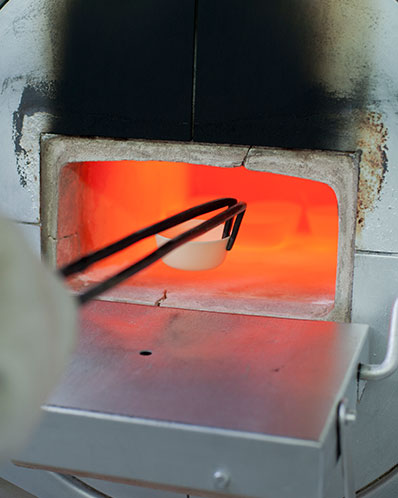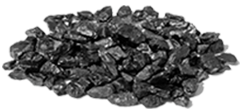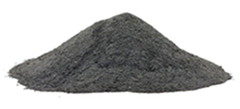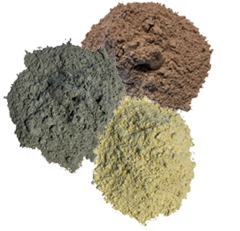Quality
100% Quality - 100% Service - 100% Expertise

Our mission is to fulfil all of the requirements of our customers. This means not only fulfilling specified product characteristics, but also meeting customer requirements with respect to packaging, lead times, document preparation and processing, and providing excellent service.
Customer satisfaction is our objective.
Our modern laboratory enables us to analyse all product properties at all stages – from raw material intake to production and shipment – and control them in a target-oriented fashion. We continuously translate our accumulated experience and knowledge into individual product developments.
Obtaining DIN EN ISO 9001 certification in 1996 strengthened both our approach and processes, with the help of DET Norske Veritas, and we are now working towards the implementation of an environmental management system to meet ISO 14001.
Typ A
Granules in grain sizes:
0 – 0,5 / 0,1 – 0,6 mm
0 – 1 / 0,1 – 1 mm
1 – 3 / 1 – 4 / 1 – 5 mm
2 – 5 / 2 – 6 / 2 – 7 mm
3- 8 / 3- 10 mm

Iron and steel industries
- Carburising, slag foaming and ladle coating materials,
- Packing compounds for graphite electrode production
Refractory Industry
- Burn-out additives for refractory bricks and additives for ramming and gunning mixtures
Glass industry
- Additives for the purification of glass melts and for adjusting the redox-relation
Typ B
Powder in grain sizes:
0 – 0,05 mm
0 – 0,10 mm
0 – 0,15 mm
0 – 0,20 mm
0 – 0,25 mm

Chemical and metallurgical industries
- Carbon carriers for casting powder and insulating materials; particularly suitable for spray-granulation processes
Refractory Industry
- Burn-out additives for refractory bricks and additives for ramming and gunning mixtures
Glass industry
- Additives for the purification of glass melts and for adjusting the redox-relation
Typ C
Mixtures:
Blackings, trough blackings, ingot-mould blackings, tundish powders, coatings, other mixtures

Iron and steel industry and iron foundries
- Blackings for moulds, cores, channels and ladles in foundries
- Trough blackings for centrifugal casting systems used to manufacture cast-iron tubes and pipes
- Ingot-mould blackings for the casting systems used to manufacture ingots from pig iron and specialty pig iron
PRODUCTS
Raw materials, additives and excipients
-
Blacking
The term blacking is used to describe highly refractory coatings applied to moulds, cores, casting gutters and casting dies to obtain smooth surfaces without burning in. The coating insulates the substrate and protects it from thermal stress caused by the molten metal. The finely ground carbonaceous materials used make these mixtures grey-black in colour.
-
Burn-out material for foundries
Fine, sieved coke is mixed into the refractory batches used for the production of refractory bricks. The carbon burns off during firing, leaving behind voids in the finished brick. This void volume provides thermal insulation.
-
Carburising Agents
The manufacture of cast iron, ductile cast iron and steel commonly involves the use of steel scrap as a feedstock, which is melted in electric furnaces. The carbon content required for casting must then be adjusted in line with the intended application. Various carburising agents are used for these adjustments. Such agents include hard coke, petroleum coke, graphite and anthracite.
-
Carburising Coal
The manufacture of cast iron, ductile cast iron and steel commonly involves the use of steel scrap as a feedstock, which is melted in electric furnaces. The carbon content required for casting must then be adjusted in line with the intended application. Various carburising agents are used for these adjustments. Such agents include hard coke, petroleum coke, graphite and anthracite.
-
Channel blacking
Blacking for casting gutters and channels in centrifugal casting. The term blacking is used to describe highly refractory coatings applied to moulds, cores, casting gutters and casting dies to obtain smooth surfaces without burning in. The coating insulates the substrate and protects it from thermal stress caused by the molten metal. The finely ground carbonaceous materials used make these mixtures grey-black in colour.
-
Coke
Coke is a porous, highly carbonaceous fuel with a high specific surface area, which is produced in coking plants, preferably through the exposure of low-ash bituminous coal (brown or black coal) to high temperatures in the absence of air (pyrolysis).
-
Coke as a reducing agent
Coke serves as a reducing agent in the production of iron.
-
Coke breeze
Coke breeze is the fine component < 20/10 mm of foundry coke. The terms coke breeze and coke fines are both commonly used.
-
Coke fines
Coke fine is normally the fine component < 20/10 mm of foundry coke. The terms coke fines and coke breeze are both commonly used.
-
Coke flour
Dried and finely ground or air-separated hard coal coke.
-
Contract mixes
Our contract mixes service utilises our plant processing procedures and equipment, as well as personnel. We combine fine dried materials such as coke flour, clay and binding agents into a homogeneous mixture in accordance with fixed formulas and then pack the finished mix pursuant to customer specifications.
-
Die casting blacking
Blacking for die casting. The term blacking is used to describe highly refractory coatings applied to moulds, cores, casting gutters and casting dies to obtain smooth surfaces without burning in. The coating insulates the substrate and protects it from thermal stress caused by the molten metal. The finely ground carbonaceous materials used make these mixtures grey-black in colour.
-
Dried coke
- water content,
- carbon content,
- ash content,
- sulphur content,
- grain size,
- solidity, and
- breeze.
Coke is produced in a coking plant using a dry distillation process. The volatile constituents of the coal are released by heating to a temperature between 900°C and 1,400°C and extracting those constituents. The degassing forms a porous coke consisting primarily of carbon and ash.
By controlling the conditions during the coking process, certain characteristics of the coke to be adjusted in line with its intended use. These include:
Today, blast furnace and foundry coke are the most common end products. Where the coke is subsequently dried under controlled conditions, the result is dried coke.
-
Glass industry
The glass industry includes all companies involved in the production and processing of glass.
-
Mould blacking
Blacking for moulds. The term blacking is used to describe highly refractory coatings applied to moulds, cores, casting gutters and casting dies to obtain smooth surfaces without burning in. The coating insulates the substrate and protects it from thermal stress caused by the molten metal. The finely ground carbonaceous materials used make these mixtures grey-black in colour.
-
Refractory wash
The term refractory wash originally comes from the field of production engineering. To “dress” means to smooth the surface of work pieces.
In foundry terms, refractory washes are coating materials applied to moulds and cores to smooth the porous surfaces of mould sections. Finely ground refractory to highly refractory materials are used as a basis. The coating insulates the substrate and protects it from thermal stress as a result of the molten metal.
-
Slag foaming
In the electrical steel manufacturing process, an electric arc or induction is used to generate the heat required to melt the metal.
The electric arc furnace is charged with scrap, sponge iron and pig iron. Lime, for slag formation, and reducing agents are also added. The electric arc, which runs from the graphite electrode to the molten metal, generates temperatures of up to 3,500 °C. This makes it possible to melt even difficult-to-melt alloying elements, such as tungsten and molybdenum, into ferro-alloys.
Electric arc furnaces can be used to manufacture all types of steel. In order to minimise temperature losses and wear to the refractory lining, a carbon carrier is injected into the furnace in a controlled manner using gas injection technology, foaming the slag. The injected carbon-carrier is known as foaming carbon.
-
Steel works
The steel industry is a branch of industry that belongs to the heavy industry sector and includes both the production of steel and, in some circumstances, the sale and distribution of that steel.

